Purple flowering bushes are always popular, especially amongst people looking to add a bit of color to their landscape. Shrubs can have flowers in different hues of purple, including mauve, lilac, violet, lavender, and plum – all of which contrast nicely with their green foliage when in bloom.
You can find purple flowering shrubs in many different forms, including deciduous and evergreen. You can use them as privacy hedges, garden beds, or walkway edging.
In this article, we compile a list of bushes with purple flowers. These bushes are sure to make a statement in your garden.
Table of Contents
1. Rose of Sharon (Hibiscus syriacus)
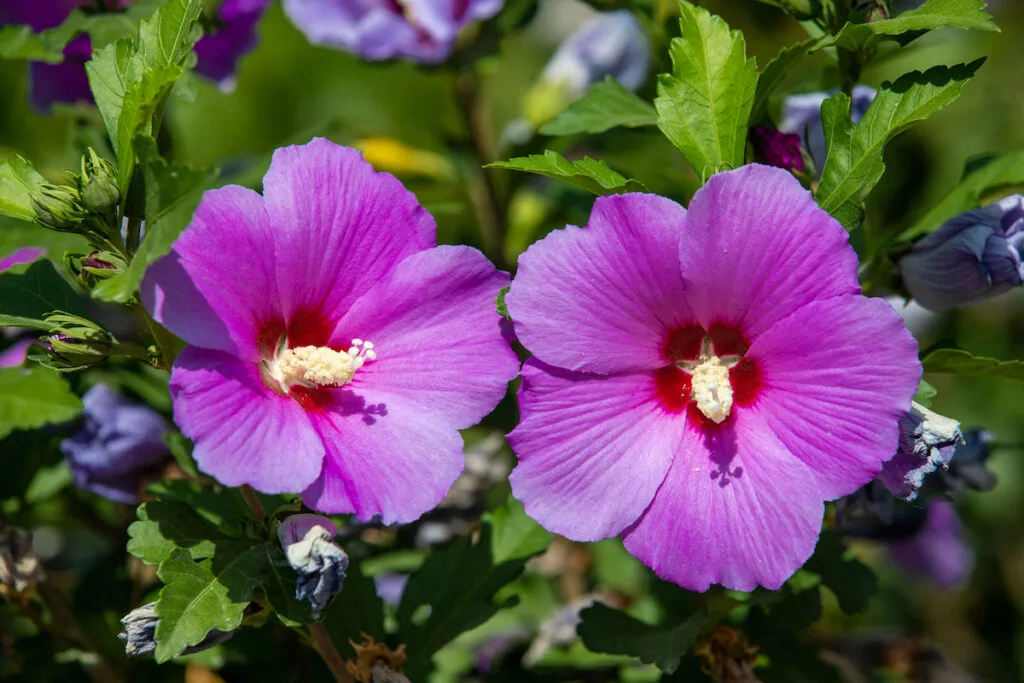
Rose of Sharon is a hardy multi-stemmed hibiscus shrub native to Asia. It produces abundant showy rounded blooms in the late summer and fall.
The five-petal flowers come in several colors including purple, pink, blue, and white. Each flower has a red-colored throat and a prominent stamen cone.
Depending on the cultivar, the purple flowers are either single or double blooms.
Rose of Sharon has a natural vase-like shape and can reach a maximum height of 12 feet. It also has multiple branches with dark green foliage.
Due to the foliage density of this deciduous shrub, it is ideal for a warm-weather privacy screen. You can also prune it into a single trunk and grow it as a tree.
Rose of Sharon thrives in moist, well-drained soil and requires full sun or partial shade. They grow best in USDA zones 5-8.
2. Lilac (Syringa sp.)
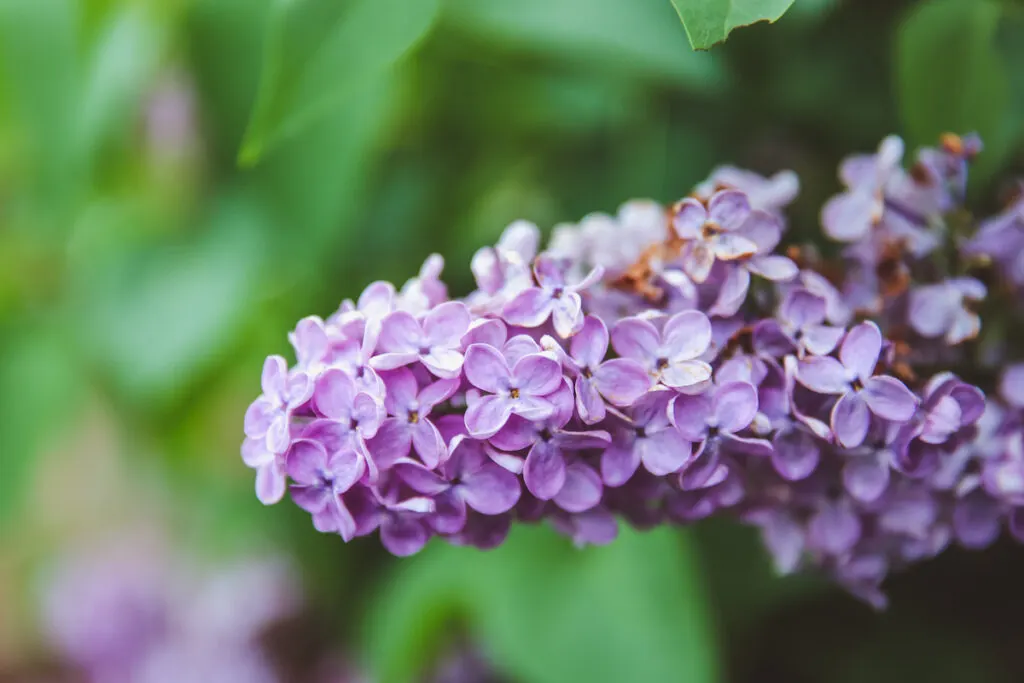
Lilac is a deciduous shrub native to Europe. But you can also find it growing in some parts of North America. It produces intensely fragrant flowers that bloom in the spring. The flowers are either purple, white, pink, or a combination of two colors.
The blooms of the Lilac appear in numerous panicles or branching clusters, with each flower measuring about 1/3-inch across. The incredible fragrance of the Lilac attracts butterflies which adds more versatility and color to your landscape.
Lilac bushes have a moderate growth rate and reach a height of about 8-15 feet at maturity. The leaves are heart-shaped with a dark–green color and a smooth surface.
Lilacs prefer loamy, well-drained soil with full sunlight. They thrive in USDA hardiness zones 3-7.
3. Rhododendron (Rhododendron sp.)
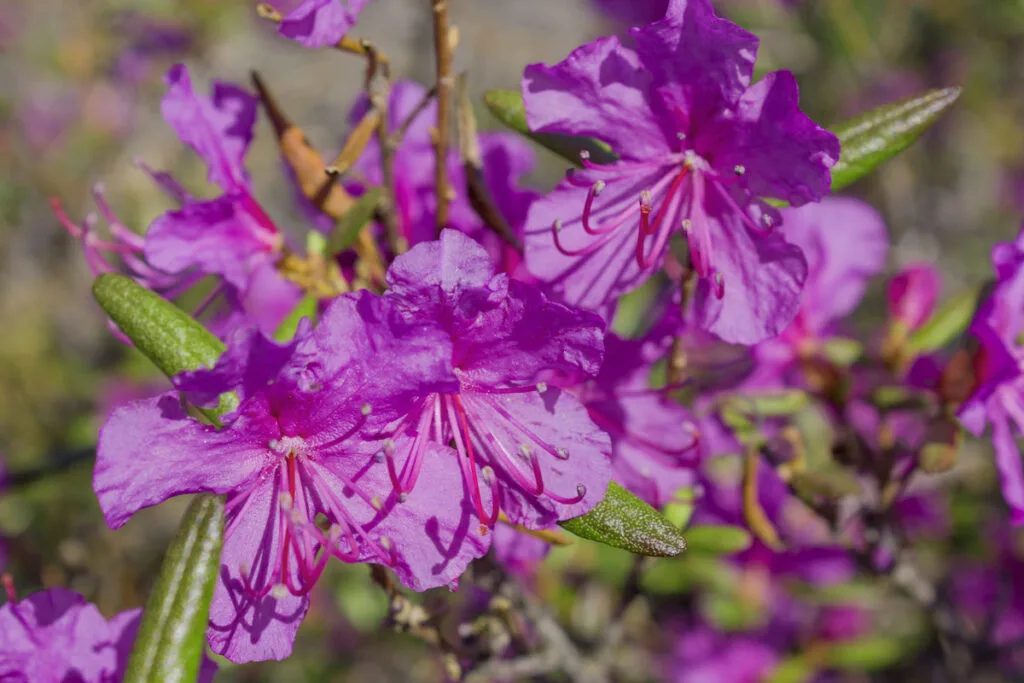
Rhododendron is a medium-sized, broadleaf evergreen shrub. It produces stunning purple, pink, yellow, red, and white blooms in late spring. However, the purple varieties are the most common, with deep purple buds that become lighter when the flower opens.
Rhododendron bloom in clusters of 4-9 flowers. The fragrant blooms are usually bell, tubular, or funnel-shaped. The leaves are large, leathery, and oblong-shaped.
Depending on the Rhododendron species, they can grow around 3-15 feet tall at maturity. Due to their dense growth, you can use them for security hedges, privacy screens, and living fences. You can also use them as a flowering hedge.
Rhododendron is an acid-loving plant that thrives with medium moisture and full sunlight or partial shade. They perform best in USDA hardiness zones 4-8.
4. Butterfly Bush (Buddleia davidii)

Butterfly Bush is a deciduous perennial shrub native to the rocky slopes in China. It is easy to grow and produces stunning deep purple cone-shaped flowers from mid-summer until fall. The flowers are also available in several colors, including yellow, pink, white, and blue.
As the name implies, this shrub attracts butterflies and other pollinators like hummingbirds. This fast-growing bush can reach about 4-12 feet at maturity. Ensure you prune this bush annually to promote flowering and keep it in shape.
Butterfly Bush is a low-maintenance shrub that performs well in well-drained soil with full sunlight. It performs best in USDA growing zones 5-9.
Butterfly Bush is ideal for perennial borders, foundation planting, cottage gardens, and container growing.
However, certain areas of the United States tag this plant as invasive because of its prolific growth and seeding rates. So, before you add this plant to your landscape, ensure you check with your local agricultural extension office.
5. Golden Dewdrop (Duranta erecta)

Golden Dewdrop is a tropical broadleaf evergreen bush native to central and South America.
Golden Dewdrops produce a vibrant cluster of star-shaped white and violet flowers that bloom in the spring. The elegant purple flowers have five petals with white borders.
Golden Dewdrops have evergreen foliage with oval or rounded leaves. Some varieties have variegated or gold leaves. It also produces clusters of golden berries in the fall when the flowers fade. However, these berries are poisonous to humans and animals.
When you grow Golden Dewdrops in a container, it can reach a mature size of 2-4 feet tall. As a perennial, it can reach about 18 feet tall.
Golden Dewdrops thrive in moist, well-drained soil with full sunlight. It grows best in USDA hardiness zones 10-11.
6. Bougainvillea
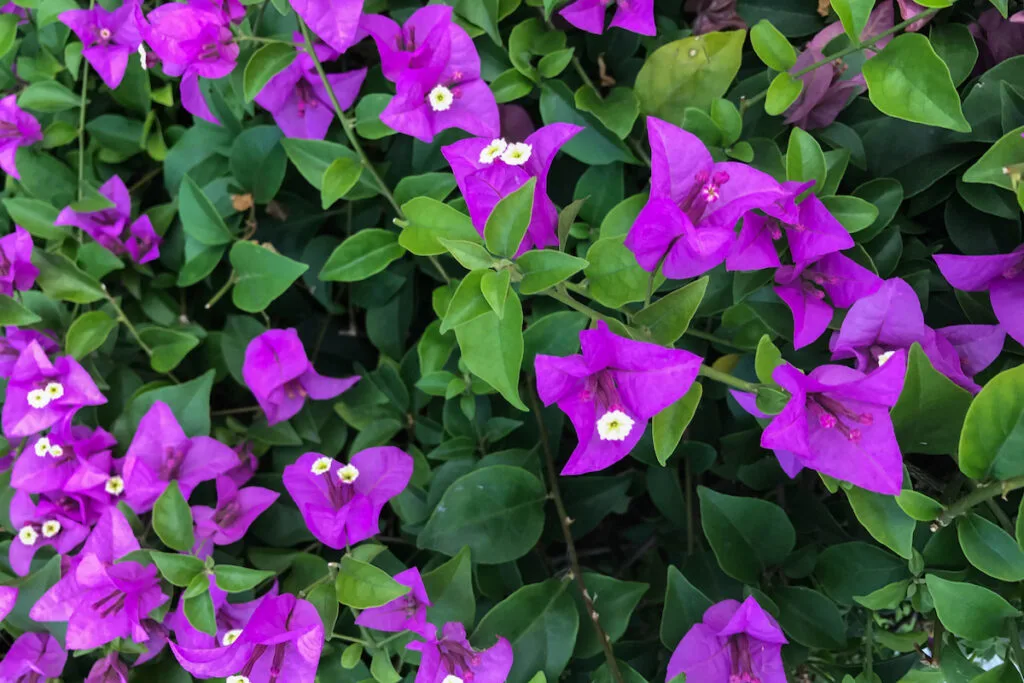
Bougainvillea is a beautiful evergreen vine-like shrub native to South America. It produces pink, purple, or magenta petal-like bracts most people assume are flowers. However, these bracts hide the true blooms of the Bougainvillea, which are small, yellow, or white buds.
Bougainvillea is a versatile, fast-growing plant you can train over fences, doors, and canopies. It is also easy to grow indoors in pots or containers, and with the right conditions, it will thrive. This vining shrub is also available in single and double blooms.
Bougainvillea grows to a mature height of 15-40 feet outdoors and 2-6 feet indoors. Pruning regularly encourages blooming and directs its growth.
Bougainvillea grow best in USDA hardiness zones 9-11. It will thrive in moist, well-drained soil with full sunlight.
7. Wisteria
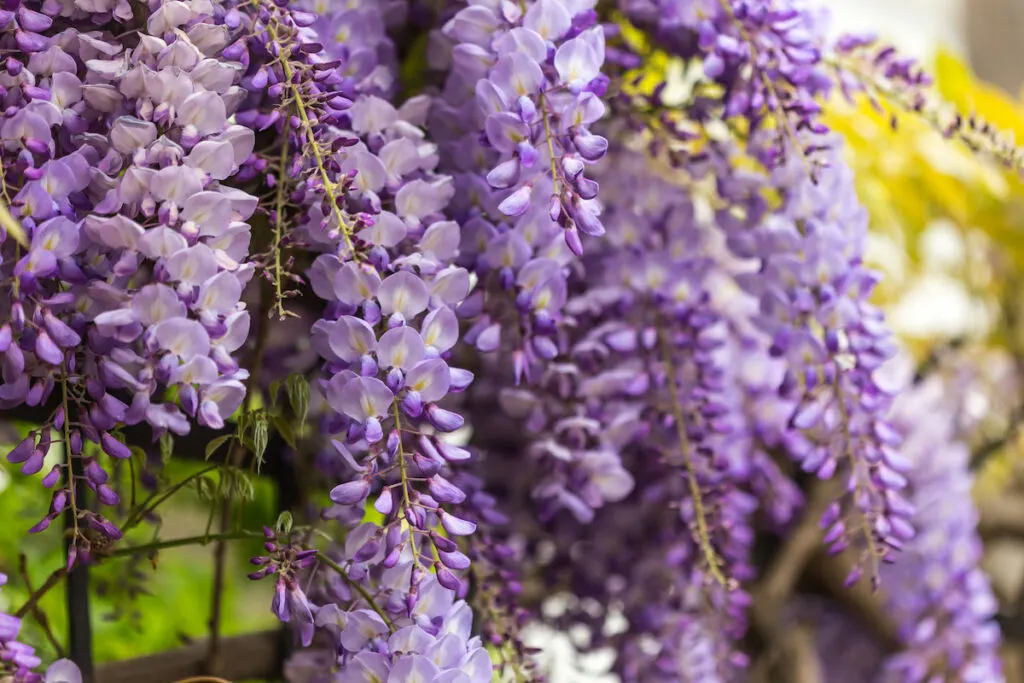
Wisteria is a deciduous perennial flowering vine native to Asia. It produces drooping clusters of fragrant purple, white, and pink flowers from May-June.
As a vine, Wisteria can grow about 10-25 feet long when it matures. Although this plant is a vigorous climber, you can train it into a thick bush through regular pruning. You can also grow it as a container shrub.
The Chinese Wisteria is an invasive plant in the United States. So, if you are keen on adding Wisteria to your garden, go for the American Wisteria because it is a less aggressive alternative.
Wisteria plants are toxic to both pets and humans. They grow best in moist, well-drained soil with full sunlight or partial shade in USDA growing zones 4-9.
8. Heather
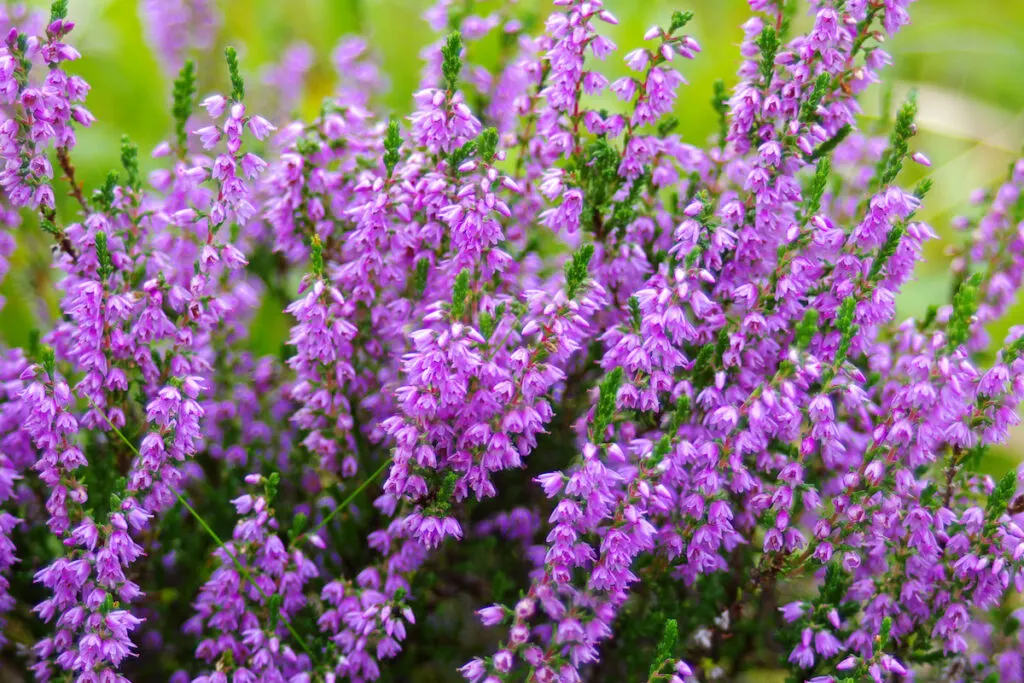
Heather is a woody, broadleaf evergreen shrub native to Eurasia. This cold-hardy bush can add a bit of color to your landscape when it blooms. Some varieties have spectacular gold or red foliage that are more attractive in cold weather.
Heather is a low growing plant that produces clusters of tiny red, purple, pink, and mauve flowers that bloom from mid-summer to early fall. The flowers grow on the end of upright stems as racemes.
Heather is a slow-grower and reaches a mature height of 24 inches and a mature spread of 24-36 inches wide. It has tiny scale-like evergreen leaves that measure about 1/8 inches long.
Heather grows best in USDA hardiness zones 4-6. It prefers acidic, sandy soil with full sunlight and partial shade.
9. Russian Sage
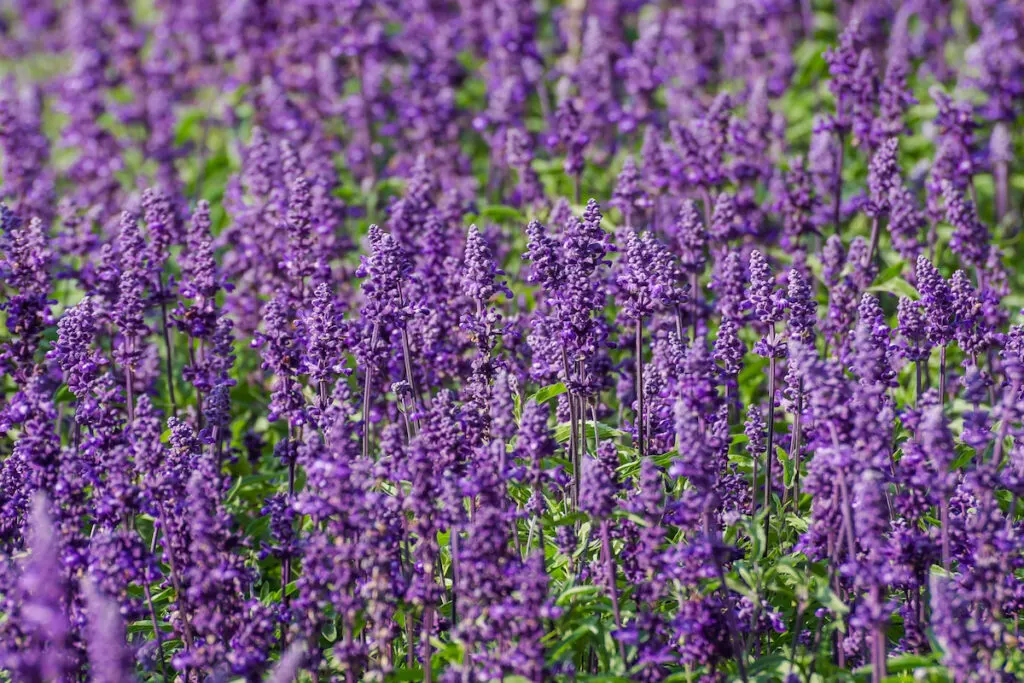
Russian Sage is an herbaceous perennial shrub with long, thin flower panicles. When the flower panicles bloom from mid-summer to late fall, it creates a lavender-blue haze.
Russian Sage foliage consists of slightly scented leaves with finely cut greenish-grey leaves. It grows to a mature height of 4 feet, with a spread of 3 feet wide.
You can grow Russian Sage in a container, shrub border, and along driveways. It is also an ideal choice for xeriscaping.
Russian Sage is a hardy and drought-resistant plant that thrives in USDA hardiness zones 4-9. It can grow in any soil and performs best with full sunlight.
Resources:
- https://www.gardenloversclub.com/plant-finder/shrubs/purple-flowering-shrubs/
- https://togethertimefamily.com/purple-bush/
- https://www.diyncrafts.com/100192/home/gardening/18-purple-flowering-shrubs-thatll-beautify-your-garden
- https://leafyplace.com/purple-flowering-shrubs/
- https://www.urbangardengal.com/purple-flowering-shrubs/
- https://www.gardeningchores.com/purple-flowering-shrubs-bushes/
- https://www.thespruce.com/shrubs-with-purple-flowers-4158008
